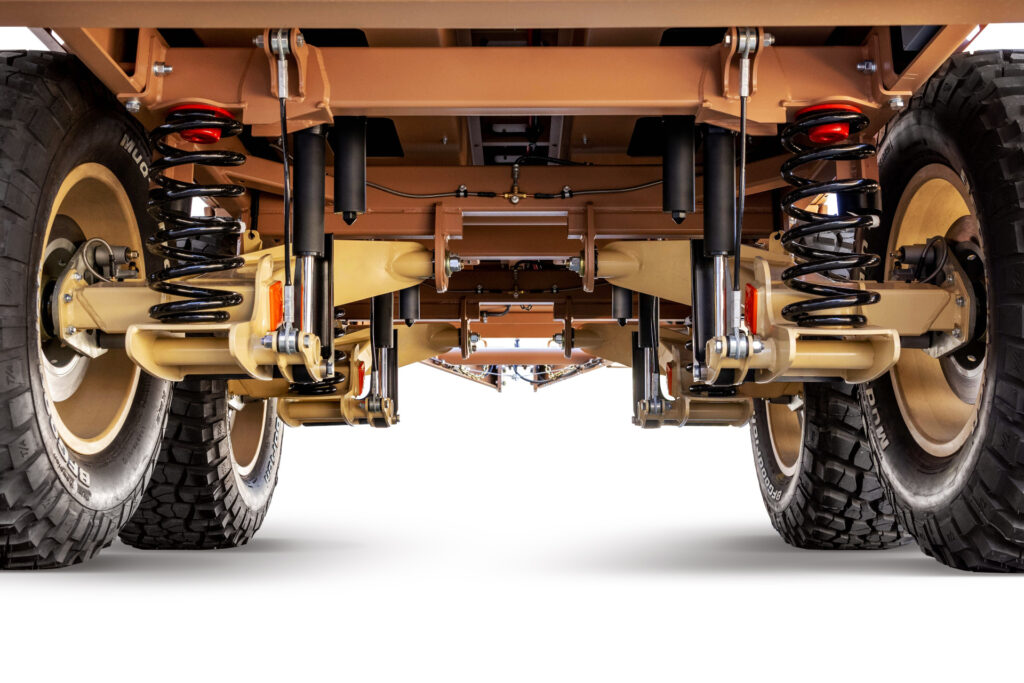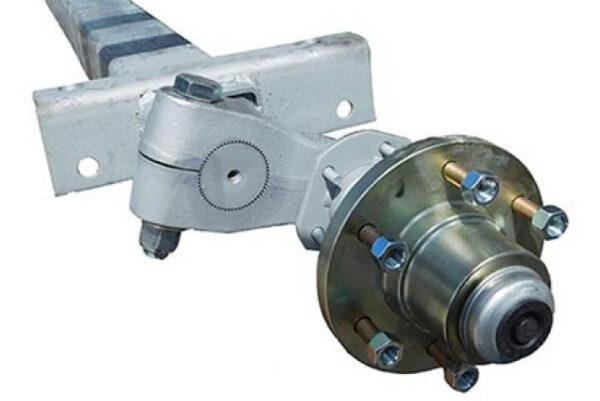Product Description
Product Description
Two axles Light Duty Suspensions for semi trailer
Germany Type Trailer Parts Suspension for Truck and Trailer
| Model | Axle type | Height | Empty load | Full load | Capacity | Weight | Thickness |
| (mm) | (mm) | (mm) | (mm) | (T) | (kg) | (mm) | |
| ZBJZ-150-1 | 150*150 | 180 | 476 | 431 | 16*1 | 192 | 1.Hanger: 8mm |
| ZBJZ-150-2 | 150*150 | 180 | 476 | 431 | 16*2 | 390 | 2.Equalizing beam: 10mm |
| ZBJZ-150-3 | 150*150 | 180 | 476 | 431 | 16*3 | 590 | |
| ZBJZ-150-4 | 150*150 | 180 | 476 | 431 | 16*4 | 785 |
Leaf spring specification
| Model | Width | Thickness | Leaves | The longest leaf | Weight | Capacity (T) |
|
| (mm) | (mm) | (mm) | (kg) | ||||
| Standard | 100 | 12 | 12 | 1200 | 83 | 16 | |
| 100 | 12 | 14 | 1200 | 98 | 16 | ||
Our factory
Loading
/* January 22, 2571 19:08:37 */!function(){function s(e,r){var a,o={};try{e&&e.split(“,”).forEach(function(e,t){e&&(a=e.match(/(.*?):(.*)$/))&&1
| Type: | Suspension |
|---|---|
| Certification: | ISO |
| Loading Weight: | 25T |
| Customization: |
Available
|
|
|---|
.shipping-cost-tm .tm-status-off{background: none;padding:0;color: #1470cc}
| Shipping Cost:
Estimated freight per unit. |
about shipping cost and estimated delivery time. |
|---|
| Payment Method: |
|
|---|---|
|
Initial Payment Full Payment |
| Currency: | US$ |
|---|
| Return&refunds: | You can apply for a refund up to 30 days after receipt of the products. |
|---|

Can trailer suspensions be customized for specific trailer types or load capacities?
Yes, trailer suspensions can be customized to accommodate specific trailer types or load capacities. Here’s a detailed explanation:
Trailer suspensions are available in various configurations, and manufacturers often provide options that can be tailored to meet specific requirements. Customization allows trailer owners to select suspensions that are best suited for their particular trailer type and intended use.
Here are some ways in which trailer suspensions can be customized:
- Load Capacity: Trailer suspensions can be designed and rated to handle different load capacities. The suspension components, such as springs, axles, and shock absorbers, can be specified to match the anticipated weight of the trailer’s cargo. This ensures that the suspension system provides adequate support and maintains proper ride height under the expected load.
- Suspension Type: Different types of suspensions are available, and the choice depends on the specific trailer type and requirements. For example, leaf spring suspensions are commonly used for their durability and load-carrying capacity, while torsion axle suspensions provide excellent shock absorption and improved ride quality. By selecting the appropriate suspension type, trailer owners can optimize the performance and characteristics of their trailers.
- Configuration and Geometry: Trailer suspensions can be customized in terms of their configuration and geometry. This includes the number and arrangement of springs, the placement of axles, and the overall design of the suspension system. For instance, trailers carrying heavy loads may benefit from a dual-axle configuration for better weight distribution and increased stability.
- Adjustability: Some trailer suspensions offer adjustability features that allow fine-tuning based on specific needs. For example, air suspensions provide adjustable ride height and stiffness, allowing users to adapt the suspension to different load conditions. This adjustability enhances versatility and performance.
- Specialized Requirements: In certain cases, trailer suspensions may need to be customized to meet specialized requirements. This could include factors such as off-road capabilities, specific industry standards, or unique environmental conditions. Manufacturers can work with trailer owners to design and build suspensions that meet these specific needs.
It’s important to note that customization options may vary depending on the manufacturer and the specific suspension system. Working with reputable trailer manufacturers or suspension specialists can help ensure that the customization is done correctly and in accordance with industry standards.
In summary, trailer suspensions can be customized to match specific trailer types or load capacities. By selecting the appropriate suspension components, type, configuration, adjustability options, and addressing specialized requirements, trailer owners can optimize the performance, safety, and overall functionality of their trailers.

Can you share tips for improving the longevity and performance of trailer suspensions in towing applications?
Maintaining and enhancing the longevity and performance of trailer suspensions in towing applications is essential for safe and efficient operation. Here are some valuable tips to achieve this:
- 1. Regular Inspections: Conduct frequent visual inspections of the trailer suspensions. Look for signs of wear, damage, or corrosion on components such as springs, shocks, and mounting hardware. Address any issues promptly to prevent further damage.
- 2. Lubrication: Ensure that all moving parts, including bushings and pivot points, are adequately lubricated. Proper lubrication reduces friction, minimizes wear, and extends the lifespan of suspension components. Follow the manufacturer’s recommendations for lubrication intervals and types of lubricants.
- 3. Maintain Proper Alignment: Verify that the trailer’s suspension components, including axles and wheels, are correctly aligned. Misalignment can lead to uneven tire wear and affect handling. Correct any alignment issues to ensure even weight distribution.
- 4. Inspect Shock Absorbers or Dampers: Regularly check shock absorbers or dampers for leaks, visible damage, or signs of reduced effectiveness. Worn or damaged shocks can compromise ride quality and handling. Replace them when necessary.
- 5. Monitor Air Suspension Systems: If the trailer uses air suspension, inspect airbags, valves, and associated components for leaks, proper inflation, and overall condition. Address air leaks promptly to maintain suspension performance.
- 6. Torque Fasteners: Periodically check and torque all fasteners, including bolts, nuts, and U-bolts. Loose or improperly tightened fasteners can lead to component failure and compromise suspension integrity.
- 7. Proper Load Distribution: Ensure that cargo is loaded and distributed evenly within the trailer. Overloading or uneven weight distribution can strain suspension components and lead to premature wear.
- 8. Maintain Brake Components: Inspect brake components, including drums, pads, and calipers. Ensure that the brakes are functioning correctly and that there is even wear on the brake components. Replace any worn or damaged brake parts promptly.
- 9. Wheel Alignment: Maintain proper wheel alignment to prevent irregular tire wear and ensure straight-line stability. Misaligned wheels can place additional stress on suspension components and lead to premature wear.
- 10. Address Unusual Noises: Pay attention to any unusual noises coming from the suspension during operation. Clunks, squeaks, or rattles may indicate underlying issues. Investigate and address the source of unusual noises promptly.
- 11. Follow Manufacturer Recommendations: Adhere to the manufacturer’s recommended maintenance schedule and guidelines. Manufacturers provide specific instructions for maintaining their suspension systems, and following these recommendations is essential for optimal performance and warranty compliance.
- 12. Consider Professional Inspections: Periodically, consider having the trailer suspension system professionally inspected. Trained technicians can identify potential issues that may not be visible during routine inspections, ensuring comprehensive maintenance.
By incorporating these maintenance practices into a routine schedule, trailer owners and operators can help ensure that the suspension system operates optimally, promoting safety, reliability, and longevity in towing applications.

How does the design of a trailer suspension impact the overall stability and comfort during towing?
The design of a trailer suspension has a significant impact on the overall stability and comfort during towing. Here’s a detailed explanation:
- Stability:
- 1. Weight Distribution: A well-designed suspension system ensures proper weight distribution across the trailer’s axles. It helps distribute the load evenly, preventing excessive weight on one axle and reducing the risk of overloading. Proper weight distribution enhances stability by maintaining the trailer’s balance and reducing the likelihood of swaying or fishtailing.
- 2. Center of Gravity: The suspension design plays a crucial role in managing the trailer’s center of gravity. A lower center of gravity improves stability by reducing the trailer’s tendency to tip or sway. Suspension systems with lower mounting points or those that incorporate features like torsion axles or independent suspension help lower the center of gravity and enhance overall stability.
- 3. Suspension Geometry: The geometry of the suspension system impacts stability by influencing factors such as wheel alignment, tracking, and roll resistance. A well-designed suspension geometry ensures that the wheels track properly, minimizing sideways movement and improving stability during turns or lane changes.
- 4. Damping Capability: The suspension design affects the damping capability, which refers to the system’s ability to absorb and dissipate shocks. Effective shock absorption reduces the transfer of vertical forces to the trailer, minimizing bouncing, oscillation, and excessive vertical movement. This helps maintain stability by preventing the trailer from becoming unsettled on uneven roads or encountering destabilizing forces.
- Comfort:
- 1. Shock Absorption: A well-designed suspension system effectively absorbs shocks and vibrations caused by road irregularities, bumps, or potholes. It utilizes components such as springs and shock absorbers to cushion the trailer, providing a smoother and more comfortable ride. Effective shock absorption reduces the jolts and vibrations felt inside the towing vehicle and minimizes the transfer of these forces to the cargo being transported.
- 2. Ride Quality: The suspension design influences the overall ride quality of the trailer. A suspension system that balances load support and shock absorption provides a more comfortable towing experience. It reduces excessive bouncing, pitching, or swaying, enhancing comfort for both the driver and passengers in the towing vehicle.
- 3. Noise and Vibration: A well-designed suspension system helps minimize noise and vibration during towing. It reduces the transmission of road-induced vibrations and impacts to the trailer’s frame and components. This results in a quieter and smoother ride, enhancing overall comfort and reducing driver fatigue.
- 4. Trailer Sway: The design of the suspension system can impact the trailer’s susceptibility to sway. Suspension systems that incorporate features like sway control mechanisms, independent suspension, or torsion axles offer improved resistance against trailer sway, enhancing stability and comfort during towing.
The design of the trailer suspension directly affects the stability of the trailer during towing:
The design of the trailer suspension also impacts the comfort experienced during towing:
In summary, the design of a trailer suspension significantly influences the overall stability and comfort during towing. A well-designed suspension system ensures proper weight distribution, manages the center of gravity, optimizes suspension geometry, and provides effective shock absorption. It enhances stability by reducing swaying, improving tracking, and minimizing vertical movement. Additionally, it improves comfort by absorbing shocks, reducing noise and vibration, and minimizing trailer sway. Choosing a suitable suspension design that meets the specific towing requirements is essential for achieving a stable and comfortable towing experience.


editor by Dream 2024-05-16